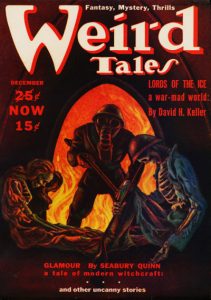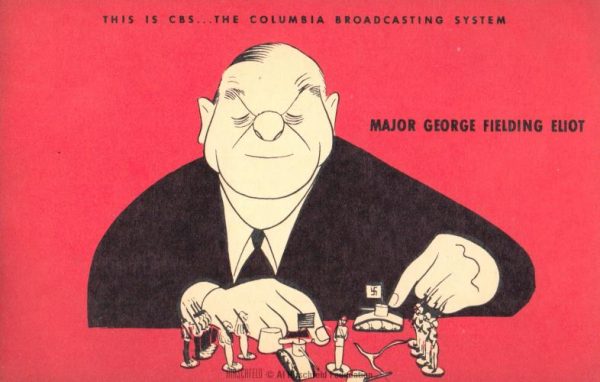 Last year marked the centennial of the armistice that ended the First World War. PulpFest 2018 honored the hundredth anniversary of the war’s end by focusing on the so-called “war pulps” of the early twentieth century and the depiction of war in popular culture.
Last year marked the centennial of the armistice that ended the First World War. PulpFest 2018 honored the hundredth anniversary of the war’s end by focusing on the so-called “war pulps” of the early twentieth century and the depiction of war in popular culture.
Major George Fielding Eliot was one of several prolific war fiction writers for the pulps. Born in Brooklyn on June 22, 1894, he emigrated with his parents to Australia when he was eight years old. While attending the University of Melbourne, he joined the school’s cadet corps. A regimental commander upon graduating, Eliot enlisted as a second lieutenant in the Australian army in 1914. Wounded twice and gassed, Eliot saw action in the ill-fated Gallipoli Campaign and on the western front. He was an acting major at war’s end.
Following the First World War and a two-year stint with the Royal Canadian Mounted Police, Eliot returned to the United States and worked as an accountant and auditor. He also enlisted in the Army Reserve, serving in military intelligence. He rose to the rank of major.
Eliot began writing fiction for the pulps in 1926. He continued to do so until the early years of the Second World War. After the war, he occasionally published a story in the men’s adventure magazines and detective digests.
Best known in pulp circles as the creator of FBI Special Agent Dan Fowler, Eliot wrote primarily for the war and air war magazines. His fiction appeared in BATTLE ACES, BATTLE BIRDS, BATTLE STORIES, DARE-DEVIL ACES, FLYING ACES, THE LONE EAGLE, NAVY STORIES, OVER THE TOP, SKY BIRDS, SKY FIGHTERS, SKY RIDERS, SUBMARINE STORIES, WAR BIRDS, and Dell Publishing’s WAR NOVELS and WAR STORIES. The Major also wrote for ADVENTURE, ARGOSY, BLUE BOOK, THE DANGER TRAIL, DETECTIVE-DRAGNET, FIVE-NOVELS MONTHLY, NICK CARTER MAGAZINE, POPULAR DETECTIVE, THE SAINT, SPY NOVELS, SPY STORIES, THRILLING ADVENTURE, THRILLING RANCH STORIES, WEST, WESTERN ROMANCES, WESTERN TRAILS, and others. For Standard Magazines’ G-MEN, Eliot wrote fourteen of the first 23 Dan Fowler adventures, including the first four stories of the series. They were published under the C. K. M. Scanlon house name.
Several of Eliot’s crime novels were also published in hardcover. His FEDERAL BULLETS was adapted and released by Monogram in 1937. It starred Milburn Stone as Federal Agent Tommy Thompson.
After moving to New York City in 1928, Eliot began to contribute non-fiction articles to such periodicals as INFANTRY JOURNAL and the NAVAL INSTITUTE PROCEEDINGS. In 1937, he co-authored the book IF WAR COMES, with Major R. Ernest Dupuy. His follow-up — THE RAMPARTS WE WATCH: A STUDY OF THE PROBLEMS OF AMERICAN NATIONAL DEFENSE — appeared a year later. He also wrote about war and military strategy for THE AMERICAN MERCURY, CURRENT HISTORY, FOREIGN AFFAIRS, LIFE, HARPER’S MAGAZINE, and SEE.
According to his obituary in THE NEW YORK TIMES, “Major Eliot was a military correspondent and analyst during World War II for THE NEW YORK HERALD TRIBUNE and the Columbia Broadcasting System. He wrote a syndicated military affairs column for seventeen years until 1967 and also was military editor of COLLIER’S ENCYCLOPEDIA. . . . From the outbreak of the war in 1939 until 1947, his column on military affairs appeared daily in THE HERALD TRIBUNE and 34 other papers, and was said to have had five million readers. In addition, Mr. Eliot was the author of a shelf of books on military topics and an indefatigable speaker, in constant demand on lecture platforms around the country. . . . Overall, Americans were heartened by Major Eliot’s writings, speeches and radio commentaries.”
On December 7, 1941, Major Eliot participated in WCBW’s historic broadcast concerning the Japanese attack on Pearl Harbor. He was also a broadcast correspondent from London with Edward R. Murrow in 1939, and part of the live CBS coverage of the D-Day invasion on December 6, 1944. He also contributed a regular military affairs column to ARGOSY from early 1944 through mid-1945. THE NEW YORK TIMES called him “the dean of military analysts during World War II.”
Major George Fielding Eliot died on April 21, 1971, following a long illness.

(“The Copper Bowl” — one of just four tales written by Major George Fielding Eliot for “The Unique Magazine” — is probably his best known and most widely read story. Often reprinted — most recently by Otto Penzler in his 2017 anthology, THE BIG BOOK OF ROGUES AND VILLAINS — the story was originally published in the December 1928 issue of WEIRD TALES. Editor Farnsworth Wright decided to run it a second time in the December 1939 WEIRD TALES, featuring front cover art by Hannes Bok. The artist’s painting illustrates David H. Keller’s novella, “Lords of the Ice,” the story of “a war-mad world.”
Al Hirschfeld’s drawing of Major George Fielding Eliot was part of a series of post cards published by CBS in 1944. Hirschfeld’s illustrations were used by CBS to advertise their radio programming in newspapers and magazines.)







